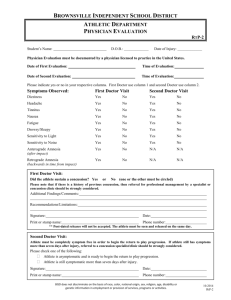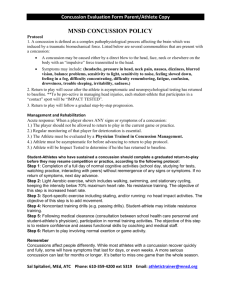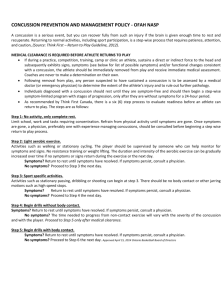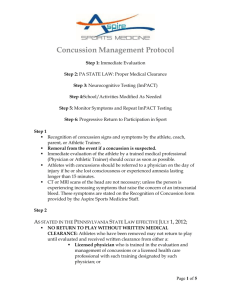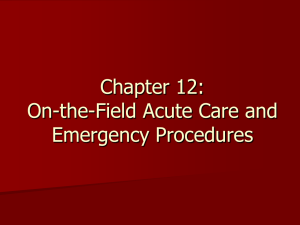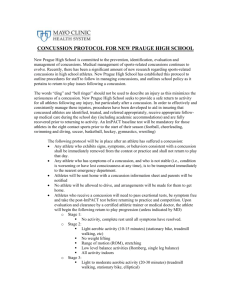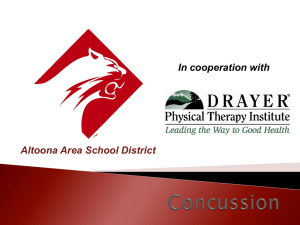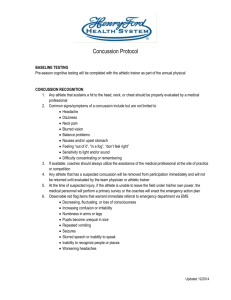HOPS Injury Evaluation: A Guide for Athletic Trainers
advertisement
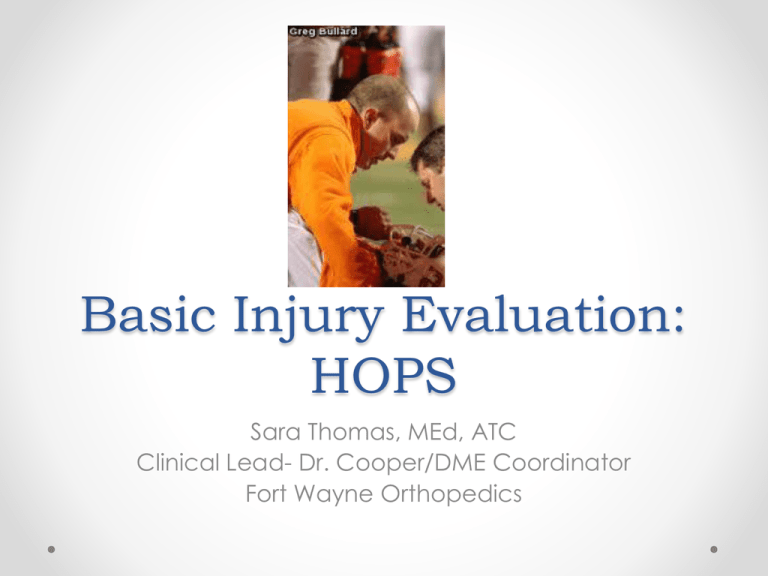
Basic Injury Evaluation: HOPS Sara Thomas, MEd, ATC Clinical Lead- Dr. Cooper/DME Coordinator Fort Wayne Orthopedics HOPS • • • • H- History O- Observation P- Palpation S- Special Testing 2 Types of Evaluations • On the Field Evaluation o Quick assessment to determine severity of injury. o Makes the decision on ability to move the athlete. o Looking for fractures, neck injury, etc. o Needs to be quick and accurate. 2 Types of Evaluation • Clinical (Off the Field) Evaluation o A more extensive eval. o May be done first, or after an on the field eval. o Should still be performed, even if you have done an eval on the field. o Trying to determine a specific cause for the problem, and a course of action. History • WHAT HAPPENED?!? • Trying to figure out the how, when and why of an injury. • A good history should give you an idea of what may be wrong before you even touch the patient. • But don’t jump to conclusions!! Types of History Questions • NOT SO GOODLeading Questions o Questions that could be answered with a yes or no. • Does your ankle hurt? • Does it hurt when you turn your ankle inward? • Does walking make it worse? • GOOD- Open Ended Questions o Questions that require an explanation. • Where does it hurt? • Which movements increase your pain? • What makes it better or worse? o Once you ask an open ended question, you can follow it with a more specific question. So Where Do I Start? • Where are you hurting? o Point with one finger. • How did this happen? o Mechanism of Injury (MOI) • The movement or force that caused the injury. o Twisting the knee with the foot planted. o A blow to the outside of the knee. • Sometimes there is not a specific mechanism. o Knowing the MOI will play a big factor in determining the problem. • When did this start? o Acute vs. Chronic Injury • Acute- Just happened. • Chronic- Has been going on for a while. More Current History • Did you hear or feel a pop or snap? • What type of pain is it? o Burning, stinging, sharp, dull, aching, tingling, stabbing, etc. o Type of pain can tell you a lot! • Does the pain change? o Time of day. o Activity level. • What makes you feel better or worse? • What have you done for it? o Meds? o Ice? o Rest? • Are you able to complete your normal activities? • Does the pain wake you at night? Previous History • Have you ever had this type of pain before? o If so, what was it? o Did you hurt it the same way? o What did you do for it? o Who (if anyone) evaluated your injury? o Did you get completely better? o Have you ever had any surgeries on this body part? General Medical History • Major Health Concerns o o o o o o • • • • Diabetes Recent Hospitalization Allergies Asthma Cardiac Conditions Sickle Cell Anemia or Trait Other Ortho Injuries Fracture History Family History Concussion History** Concussion History • Previous Concussion? o How many? o Dates of concussion. • Duration of symptoms? o How long did you sit out? • How does this concussion compare to the last one? • Complete recovery? o Any lasting symptoms? Observation (aka Inspection) • Looking at the body to see any abnormalities. • Total body observation. o This should start the second you see the athlete. • Is the athlete conscious? • Are they moving? • Are any body parts deformed? • Do you see blood coming from anywhere? • Are they limping? • How are they holding the body part that hurts? o Very important with elbows and shoulders. o Watch their expressions. Keep Looking!! • Specific body part observation. o Is there anything weird about it?? • Bruising? • Redness? (Discoloration) • Open sores or cuts? • Swelling? • Deformity? • Scars from previous injuries? • Always compare to the other side. • If you are paying attention during a game, you may be able to catch a mechanism. What do you see?? What do you see?? What do you see?? Palpation • Using the fingers to touch and feel the body structures to find problems you couldn’t find with observation. o Palpation has a pattern: • Start away from the injured area and work towards the injury. • Start with bones and ligaments first. • Then move to muscle, tendon and other soft tissue. • Then check anything else (pulses, etc.) • Knowing your anatomy is key! • Don’t forget to wear gloves, if needed!! Palpation Definitions • Symmetry o Muscles o Bones • Local Heat o Redness and hot feeling skin around the injured area. • Point Tenderness o Exact spot where it hurts. o “Pointing” to the spot. • Crepitus o Creaking, cracking, crunching, etc. o You might be able hear it, too. Activity Time!! • • • • Wrist Flexors/Extensors Crepitus, anyone?? AC Joint Anatomical Snuff Box We Are ALMOST There!! Special Tests • • • • • • • • Fracture Testing Range of Motion Ligament Testing Special Testing Neurological Testing Strength Testing Functional Testing Sport Specific Testing Wait A Minute– Is it Broken?? • Fracture Testing o Tap Test o Squeeze Test • Very Important Step!! o All other testing stops if you suspect a fracture. o Risk of displacement. • Can damage other structures. • Can lead to surgery. Range of Motion • Two Types o Active Range (AROM) • How much the athlete can move the body part on his own. o Passive Range (PROM) • How much you can you move the body part for the athlete. Ligament/Other Special Testing • Specific by body part. • Testing to see if a ligament is torn. o Can tell you the severity of injury, depending on the end point. • End Points o Solid End Point • Joint movement has a stopping point. o Soft End Point • Joint movement seems to go farther than it should. • Soft endpoints are a signal that something is wrong. • Testing for Cartilage Tears • Testing for specific conditions. • Compare to the other side! Strength Testing • Tells you the severity of injury to the muscle. o Graded on a scale from 0 to 5. • Looking for TWO things. o Pain o Weakness • Break Testing • RROM Testing Neurological Testing • Sensation Testing o Does the sensation feel the same on both sides? o Do with eyes open and eyes closed. • Tap testing o Ulnar Nerve example • Reflexes Functional Testing • Testing to see how well the athlete can use the injured body part. o o o o o Walking Running Cutting Overhead Movements Throwing Sport Specific Testing • Testing to determine ability to play. • Pitching • Sport Specific Movements o o o o Football Stance Shooting Cone Drills Volleyball Attack The End Result • Assessment vs. Diagnosis o Athletic Trainers make assessments based on their evaluations. o A diagnosis can only be made by a physician. Thank You!!

